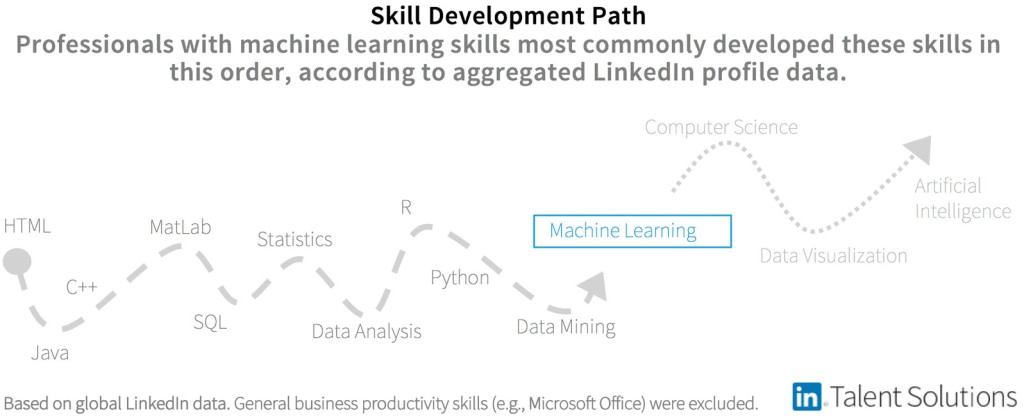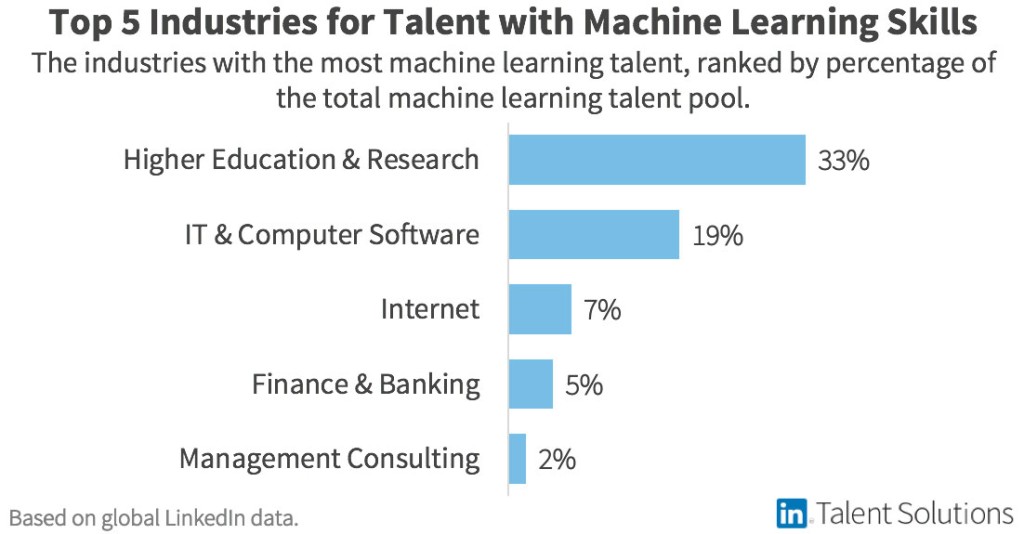3 Unconventional Strategies for Recruiting Machine Learning Talent
Don’t call it a buzzword: machine learning is already one of the most in-demand skills, according to LinkedIn data—and demand for it is growing at an extremely rapid pace.
That means you’ll be facing fierce competition if you’re one of the many recruiters on the hunt for machine learning (ML) talent.
It also means you may have to get a little creative in your sourcing strategies. So we’re bringing you three actionable insights from LinkedIn data that can help you find machine learning skills by looking just a bit off the beaten path.
Derived from LinkedIn data, these insights can help guide your search by outlining the most common paths people with machine learning skills take—and where they go when their career path pivots into a new industry.
1. Upskill talent with these skills—they’re among the most likely to learn machine learning
If you can’t hire ‘em, upskill ‘em, as the age-old saying goes. Along with targeting talent with the exact skills you’re looking for, you can search for candidates with related skills who could be taught the skills you need.
Instead of competing for people with machine learning skills, it might be worth hiring candidates or finding existing employees who are well-positioned to develop machine learning skills.
Of course, you’ll need to know which employees would be best equipped to learn ML skills. That’s where this skill development analysis comes in: it shows the skills most commonly held by ML talent—and, crucially, the order in which they learn those skills.
Professionals take all kinds of varied paths to developing machine learning skills, but we can start to see helpful patterns in aggregate. We analyzed all LinkedIn members with machine learning skills to see what other skills they most commonly share—and, crucially, the most common order in which they develop those skills (i.e., add them to their LinkedIn profile).
So the candidates and employees best suited for ML upskilling may have data mining chops, Python programming proficiency, and righteous R skills. These are the the skills most commonly developed right before machine learning (which makes sense, since Python and R are often cited as two of the top languages for machine learning.)
Skills learned early on the path to machine learning proficiency include Java and C++, common programming languages. That doesn’t mean that Java or C++ are prerequisites to learn ML, but it does give you a sense of the type of talent that often goes on to develop machine learning skills: professionals with engineering, IT, and computer science backgrounds.
Whether you’re looking to source internally or externally, targeting and training people with these skills is a great (and likely more affordable) way to add machine learning skills to your team.
2. Source machine learning talent outside your own industry
Currently, those with ML skills tend to be clustered into a few industries, with one-third (33%) in higher education and research. (This includes researchers, faculty, and, to a lesser extent, students who may list their current work experience at a school on their LinkedIn profile.) The software and internet industries together claim over a quarter (26%) of all machine learning talent, with the rest of the talent pool spread in smaller amounts across other industries.
Fortunately for talent acquisition, professionals with ML skills aren’t too shy about jumping to a new company. Last year, 22% of people with ML skills changed jobs, according to LinkedIn data. And here’s even better news for recruiters looking to source ML talent from new places: 72% of those ML-skilled folks who changed jobs last year also changed industries.
If you’ve been tasked with bringing machine learning skills to your organization, chances are good that you’ve already scoped out your immediate competitors. Looking beyond your own industry can help you expand your talent pool and increase your odds of landing someone with those sought-after skills.
In the visualization below, you can see where the most machine learning talent is pivoting into your industry—meaning they’re more likely to be good sources for you.
Don’t worry: that chart resembling knotted-up spaghetti is way less complicated than it looks. It traces the paths of people with ML skills who pivoted from one industry to another over the last year.
Find your own industry on the right to see which industries (on the left) are the biggest sources of ML talent pivoting into your space. The internet industry, for example, receives some ML pivoters from higher ed and research, more from the software industry, a tiny bit from finance, and the rest from other industries. The chart on the right shows the net movement of those with machine learning skills who changed jobs and industries over the last year.
One insight that immediately jumps off the screen: higher education and research is a HUGE source of pivoting machine learning talent. In fact, it’s a pretty great source of people with ML skills period: over 1 in 3 such people on LinkedIn started their careers in this industry, primarily serving as researchers.
In particular, higher education and research is an important source for pivoting ML talent going into “Other” industries. In other words, if you’re not in one of the industries on the graph above, higher ed and research is probably the first place you should look when sourcing ML talent from outside your industry.
Along with the internet and software industries, the finance and banking industry was a big net gainer of ML talent, with 6.6% of all pivoters moving into the industry and only 5.4% moving out. (To put that a different way, banking gained over 22% more pivoting talent than it lost.)
Whatever industry you’re in, you can use the insights above to help you see where you’ll be able to peel off ML talent that’s ready to pivot into your industry.
3. Target ML talent with these other skills—they’ll be more likely to pivot to your industry
Of course, machine learning isn’t the only skill these professionals have. By looking at the other skills held by machine learning talent pivoting into your industry, you can find those who may be more likely to join your company.
Below, we’ve outlined those “transferable” skills for the internet, software, finance, and consulting industries. If you work in one of these, you may want to search for ML talent with the skills listed below, as they’re the most likely to pivot into your industry.
For example, people with machine learning skills who pivoted into the consulting industry tended to have skills that could translate ML findings into strategic business decisions. ML pivoters heading into the software industry, on the other hand, were much more likely to have a broad range of programming skills.
When searching for candidates with machine learning skills, try refining your search to candidates who also have the above skills (based on your industry)—you'll have a much more targeted list of candidates who are more likely to pivot into your open arms.
So if you’re in consulting, you may want to add skills like business intelligence, data visualization, and leadership to your search. And if you’re recruiting in the software industry, you may want to filter your search for those with programming skills like PHP, JavaScript, and Java.
Use these insights to look beyond the same sources
Machine learning is one of the most in-demand skills. It can feel like everyone’s competing for the same small talent pool, especially when you’re looking within your own industry.
Leveraging the data here can help you get a new perspective and perhaps a competitive edge. Whether you look for high-potential talent able to be upskilled or start sourcing more from outside industries, talent intelligence can help you find the right candidates in unexpected places.
Methodology:
The analysis was based on global LinkedIn data for the period between April 2017 and March 2018. All skills in this analysis are based on skills that members have listed on their LinkedIn profiles. Demand is based on the average number of Recruiter InMails sent to professionals with each of these skills.
"Machine learning talent” here means LinkedIn members with at least one machine learning skill listed on their profile, e.g., “Machine Learning,” “Natural Language Processing,” “Text Mining,” etc. Members’ industries are based on the categorization of the companies listed on their profile. “Machine learning pivoters” are members with machine learning skills who changed jobs and industries over the last year.
To determine the top transferable skills, we analysed which skills are more prominent for machine learning talent who pivoted into each of these industries in the past year, compared to all other machine talent who changed jobs during the same period. Only skills with a difference of over 5pp were considered.
To receive blog posts like this one straight in your inbox, subscribe to the blog newsletter.
Topics: Data insights
Related articles





